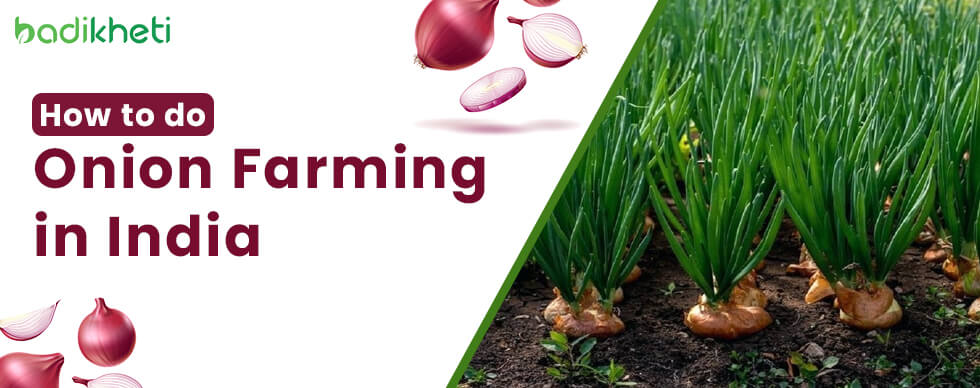
Onion farming is a profitable and rewarding activity for farmers in India. Onions are widely used in Indian cuisine and have many health benefits. The cultivation of Onions is done in most states of India.
Growing quality Onions from seeds to get high production is every farmer’s dream, Here we have provided steps that can help them to achieve it.
To grow onions successfully, farmers need to follow these 7 steps:
Step 1. Choose a suitable variety of onion seeds to buy that can adapt to the local climate and soil conditions. You can find high-yielding varieties in India at Indian agriculture marketplaces such as Badi Kheti.
Step 2. Prepare the soil by plowing it to a fine tilth and adding organic manure or compost. Keep in mind that the Onion seeds should be well-drained and have a pH of 6.5-7.5.
Step 3. Sow the onion seeds or sets in raised beds or furrows at a spacing of 15 cm x 10 cm. The seeds of the Onion should be sown at a depth of 0.5 cm and the sets have to be planted at a depth of 2.5 cm with the pointed end facing up.
Step 4. Irrigate the onion crop regularly and avoid waterlogging or drought. The frequency and amount of irrigation depend on the soil type and weather conditions. For better results, you need to maintain your organic soil to farm potential crops. Generally, onion crops need irrigation every 7-10 days during the vegetative stage and every 3-4 days during the bulbing stage.
Step 5. Fertilize the onion crop with nitrogen, phosphorus, potassium, and sulfur according to the soil test results and crop requirements. Apply half of the nitrogen and all of the phosphorus, potassium, and sulfur as a basal dose before planting. Apply the remaining nitrogen in two splits at 30 and 45 days after planting.
Step 6. Weed the onion crop manually or by using herbicides to prevent competition for nutrients, water, and space. Weeding should be done at least twice during the crop cycle, once at 20-25 days after planting and again at 40-45 days after planting.
Step 7. Harvest the onion crop when the tops start to fall over and turn yellow or brown. This usually happens after 90-120 days of planting depending on the variety and season. Cut off the tops and roots and let the bulbs dry in the sun for a few days before storing them in a cool and dry place.
By following these steps, farmers can cultivatehealthy and high-quality onions that can fetch a good price in the market.
One can also grow Onions from seeds at home. Follow the simple procedure to grow Onions at home and have fresh onions whenever you like.
Introduction Chilli fondly known as "Mirchi" in Hindi holds great cultural and historical significance in India. It is not merely a culinary delight but an integral part of our traditions with significant links to agriculture and daily life. India takes great pride in being one of the leading producers and consumers of chillies globally, with various regions contributing to this spicy farming. This article aims to analyze the primary states involved in chilli cultivation within India, exploring their unique functions within the flourishing chilli industry....
The Indian economy is based on agriculture, and the farmer's livelihood relies on the rain in monsoon season. But it isn’t certain, so depending entirely on it may affect soil management and agricultural yields. Crops need a proper quantity of water for their development. The only means our farmers can keep storing and using water properly is via irrigation. In this blog, we will understand the irrigation methods for excellent water management for Indian farmers. Undoubtedly, the world’s agricultural area has increased in the past,...
Onions, also known as Pyaaz, or Kanda are the heart of India and are a lucrative cash crop for farmers here. If you’re looking to maximize onion seed growth and yields, there are certain farming practices that you have to consider. So, proper agricultural practices are critical to maximizing onion output and quality. For the best product, you must have quality onion seeds and proper agriculture equipment in place which you can buy from an online agriculture marketplace like BadiKheti. In this blog, we will...